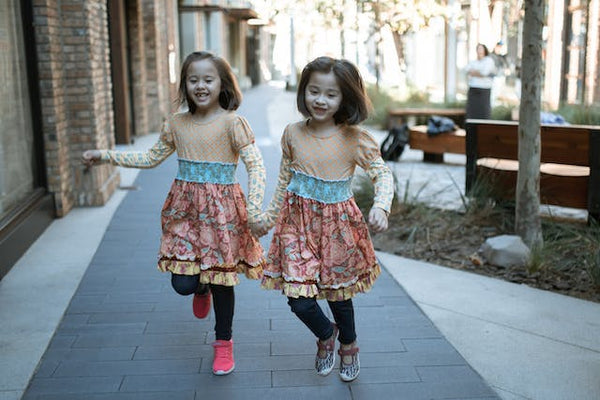The Chances of Having Twins: What Really Increases the Odds?

“What are my chances of having twins?”
It’s a question a lot of people ask when they find out they’re expecting. Whether it’s something you’re hoping for or not, it can be beneficial to understand what may enhance the likelihood of a multiple pregnancy. Many people already know that fertility interventions can heighten the probability of multiple pregnancies, but there are other variables like your size, age, dietary habits, and family medical background that can either improve or reduce your chances of conceiving multiple children simultaneously. (That said, there are no certainties—and irrespective of your efforts, most folks will ultimately end up being pregnant with only one baby.) Let’s take a closer look at the factors that influence the likelihood of giving birth to twins.
What Are the Chances of Having Twins?
According to Center for Disease Control (CDC) birth statistics for 2019 in the United States, there were 120,291 twin births, accounting for approximately 3.21% of live births, or 32.1 twins per 1,000 live births. Triplet births numbered 3,136, and there were only 150 quadruplet and higher-order births during the same year. These figures encompass both naturally occurring and fertility treatment-induced multiples. In the general population, identical twin pregnancies occur at a rate of 0.45%, or about 1 in 250 births. However, fertility treatments double these rates, significantly increasing the likelihood of having twins. While most fertility-assisted multiple pregnancies result in fraternal twins, the use of fertility treatment also elevates the risk of having identical twins.
Factors That May Increase Your Odds for Having Twins
Remember, fertility treatments aren’t the only factor that can raise your likelihood of having twins or other higher-order pregnancies. There are other factors that can boost your chances of conceiving multiple offspring. Here are a few of the most common.
Genetics
If identical twins run in the family, you don’t necessarily have an increased chance of conceiving multiples (though it’s worth noting children of male identical twins may have higher odds of conceiving identical twins themselves). That said, a family history of fraternal twins (not identical) may increase your odds of a multiple pregnancy. Fraternal twins on both sides of the family increase your chances even further.
Diet
The foods you consume can influence your chances of having twins. Some research suggests that a high intake of dairy products increases the likelihood of conceiving twins. One study observed that vegans had a significantly lower twin rate (20%) compared to those who consumed dairy. Researchers believe that diets rich in dairy, particularly in regions where cattle receive growth hormones, may enhance the chances of multiple pregnancies by stimulating the ovaries. Additionally, another study linked the consumption of yams to a higher twin rate, possibly due to yams also potentially stimulating multiple ovulation.
Age
Individuals aged 30 and above, especially those over 35, have a higher likelihood of having twins. This is due to the increase in follicle-stimulating hormone (FSH) levels as individuals age. FSH plays a role in egg development in the ovaries prior to release. With aging, higher FSH levels become necessary because eggs need more stimulation to mature. Occasionally, this heightened FSH can lead to an excessive response from the follicles, resulting in the release and fertilization of multiple eggs, thus increasing the chances of a multiple pregnancy.
Size
Individuals who are taller than the average height tend to have a higher likelihood of giving birth to twins. In one study, it was observed that individuals with an average height of 164.8 cm (about 5'4.8") were more prone to conceiving twins compared to those with an average height of 161.8 cm (about 5'3.7"). While the exact reason for this phenomenon remains unclear, one hypothesis is that improved nutrition (which could contribute to increased height) may play a role in the higher rate of twin pregnancies.
Individuals with a greater body weight also have a higher chance of having twins compared to those with a lower weight. The presence of excess body fat often results in elevated estrogen levels, which can overstimulate the ovaries. Instead of releasing a single egg during ovulation, the ovaries may release two or more eggs. It's important to note that while the likelihood of twins may rise, being overweight can also bring about other factors that generally make conception more challenging.
Nursing
Conceiving while breastfeeding can increase the likelihood of having twins, although breastfeeding typically acts as a fertility suppressant, especially in the first six months when exclusive breastfeeding is practiced. Nonetheless, it is possible to become pregnant, even with twins, while breastfeeding. In one study, the rate of twins among breastfeeding individuals was 11.4%, while among non-breastfeeding individuals, it was only 1.1%.

Why Fertility Treatments May Increase the Odds of Having Twins
The increasing rate of multiple births is primarily driven by the expanded use of fertility treatments, with over 30% of twins and 75% of triplets and higher-order multiple births now attributed to these treatments, according to the CDC. Fertility treatments often lead to fraternal twins because they stimulate increased ovulation, resulting in a higher chance of releasing and fertilizing two or more eggs in a single cycle. Research indicates that fertility treatments also double the risk of identical twins, accounting for 0.95% of pregnancies conceived through fertility treatment. The exact reasons for this phenomenon remain unclear.
What Are My Chances of Having Twins With IVF?
Across all age groups, the likelihood of having a multiple pregnancy through IVF (in-vitro fertilization) is approximately 30%, with most of these cases involving twins. The key factors influencing these odds are the number of embryos transferred and the age of the patient. In the past, to address lower implantation rates per individual embryo, many embryos were transferred, leading to a high rate of multiple births. Although the American Society of Reproductive Medicine (ASRM) strongly recommends single embryo transfer for patients with a good prognosis (the most effective way to avoid multiples), not all fertility clinics adhere to these guidelines, and not all patients choose single embryo transfer despite recommendations and counseling.
While there has been an increase in the use of single embryo transfer in recent years, the majority of transfers still involve two embryos for various reasons. Many couples undergoing fertility treatments are emotionally invested in the process, and emotions can heavily influence decision-making. Therefore, it's crucial for patients to receive counseling regarding the risks, benefits, and alternative options available in assisted reproductive technology, including the order of embryo transfer, the risks associated with multiple pregnancies, and the screening tests and technologies that can yield the best outcomes.

What Are My Chances of Having Twins Again?
According to Twins Trust, the likelihood of having another set of twins depends on whether the existing twins are identical or non-identical. If they are identical, the chances are the same as for most women, approximately 1 in 250. However, if the existing twins are non-identical, the odds of having twins again are significantly higher. Women with a family history of non-identical twins have an increased probability of having non-identical twins themselves, as there is a genetic tendency for hyper-ovulation. It's important to note that there is no known genetic link for identical twinning.
The Bottom Line on Your Odds of Having Twins
The likelihood of having twins depends on various factors, including family history, age, size, and more. While the idea of having twins might be appealing, especially for couples dealing with infertility, it's generally advisable to aim for a healthy singleton pregnancy. Your doctor can help reduce the risk of multiples through careful monitoring and single-embryo transfer during IVF. However, if you do end up expecting twins or more, it's reassuring to know that good prenatal care can minimize the risk of complications.
Strollers have come a long way! Today's strollers are designed to expand with your growing family and easily accommodate two or more children (even children the same age)! Take a look at ANB Baby's full selection of premium double strollers and find the best fit for your family!










